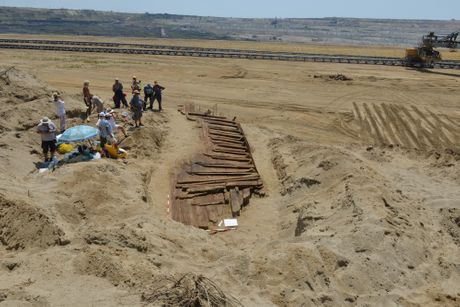Remains of ship at least 10 centuries old found near Serbia's Viminacium Roman site

The remains of a ship at least 10 centuries old were discovered in the strip coal mine Drmno near the Archaeological Park Viminacium, reported RTS. This is the fifth ship found over the last three years in the area of Viminacium, eastern Serbia - once the capital of the Roman province Moesia Superior.
Discovered at a depth of 8 meters, the remains of this vessel indicate that it is a barge modeled after Roman vessels, which was used to transport people and goods.
"Only the bottom and partially the sides are preserved. That bottom was made of oak planks, they were joined by a system of wedges and transversed forked beams fastening the sides of the ship. The stern and the central part have been preserved. Unfortunately, a (coal) dredger hooked into the front of the ship, but it was only partially damaged. 13 meters have been preserved, it was probably up to 20 meters long," Mladen Jovicic, an archaeologist from Viminacium, explained for RTS.
Archaeologist Nemanja Mrdjic recently told Tanjug that this ship was found more than 400 meters away from the closest present-day watercourse and that it is well preserved.
"The ship is much larger than the one found in 2020. The preserved length is 13 meters, and it was certainly longer, probably more than 20 meters, since it is a meter wider than the previous ship," he said.
He added that Viminacium is full of surprises and that just when you think you have it all figured out, something new happens.
The science portal LiveScience also wrote about the discovery. They reminded their audience that Viminacium was a Roman settlement and military fortification, to after 87 AD become the capital of the Roman province Moesia Superior (Upper Moesia).
With a population of 45,000 people, it is believed to have been one of the most densely populated places in this part of the Balkans, as well as being home to two Roman legions.
The town and the fortifications were destroyed in 441 by the Huns under the command of Attila, and it was rebuilt in the time of Emperor Justinian in 535.
Viminacium experienced its final decline in 582, during the invasion of Avars and Slavs. It was discovered in the 19th century and is one of Serbia's most important archaeological sites.
(Telegraf Nauka/RTS)
Video: Zafranović: David je ostavio veliki trag u srpskoj kinematografiji
Telegraf.rs zadržava sva prava nad sadržajem. Za preuzimanje sadržaja pogledajte uputstva na stranici Uslovi korišćenja.

